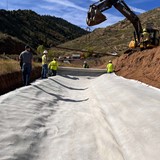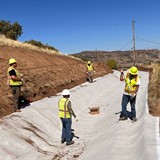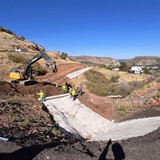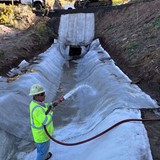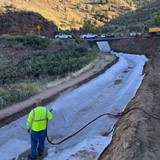Long Term Solution to Erosion in Colorado
RCR-17® | Mountainside Erosion Control
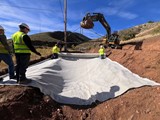
Getting Started
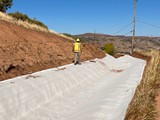
Slope Stabilized using Reinforced Concrete Roll®
Project Objectives Using Reinforced Concrete Roll®
PROJECT OVERVIEW
A popular hiking trail running through a gulch was facing serious erosion issues, compromising the stream bank and threatening the integrity of the trail. To protect both the stream bank and the trail, a reliable and environmentally friendly erosion control solution was essential.
PROJECT GOAL
- Provide a durable erosion control solution to stabilize the bank and protect the trail.
- Minimize environmental impact by selecting an eco-friendly material.
- Ensure a fast and budget-friendly installation due to limited access to the site
- Address the high velocity of water flow within the stream
- Maintain public access and safety during the installation process.
- Manage logistical constraints imposed by a narrow, high-traffic access road.
KEY TAKEAWAYS
- Proper grading and subgrade preparation.
- On-site training and comprehensive guidance for future maintenance by the city's maintenance team.
Long Term Protection for Popular Hiking Trail
Site Conditions and Technical Considerations
The project site is situated on a steep mountainside with challenging terrain, requiring careful consideration of water flow dynamics and limited access. The stream that parallels the hiking trail has a high velocity, which directed intense water flow against the bank, accelerating erosion. The narrow, two-lane road leading to the site included numerous switchbacks, restricting the transport of large vehicles and heavy equipment. Additionally, the site is a major tourist access point, so safety protocols were paramount to protect both the crew and the public during installation.
Project Description
To address the erosion concerns, the RCR-7 reinforced concrete roll was selected for its effective erosion control properties and ease of installation. A temporary access road was carved on the uphill side of the stream, providing a staging area for the excavator. Using this access point, the excavator reformed the eroded stream bank and facilitated the precise installation of the RCR panels, each of which covered 65 feet of stream bank. County maintenance crews, despite having no prior experience with RCR, managed to complete the entire installation within a single day. Approximately 400 linear feet of the stream bank was armored, stabilizing the trail and stream bank without requiring extended closures or causing significant public disruption.
Project Outcome
This project was a resounding success, meeting all technical and environmental goals. RCR-7 proved to be the optimal choice due to its flexibility, durability, and efficient installation process. The project was completed within the designated timeframe and budget, achieving stable erosion control with minimal environmental impact. The quick installation reduced public inconvenience, and safety measures ensured that the high-traffic hiking trail remained accessible. RCR-7’s ease of application allowed the maintenance crew to execute the project effectively, despite limited prior experience, making it an ideal solution for projects with tight timelines and challenging access conditions.
In terms of cost-effectiveness, RCR-12 emerged as a superior choice compared to traditional concrete or shotcrete, providing significant savings. This case study highlights how an innovative approach, coupled with meticulous planning, resulted in the successful armoring of the failing slope, safeguarding the chemical facility’s perimeter.
Ask for a product sample or speak to one of our experts.
Leo Cortez | Product Manager
Cell: (509) 770-0602
Email: leoc@inlandtarp.com

